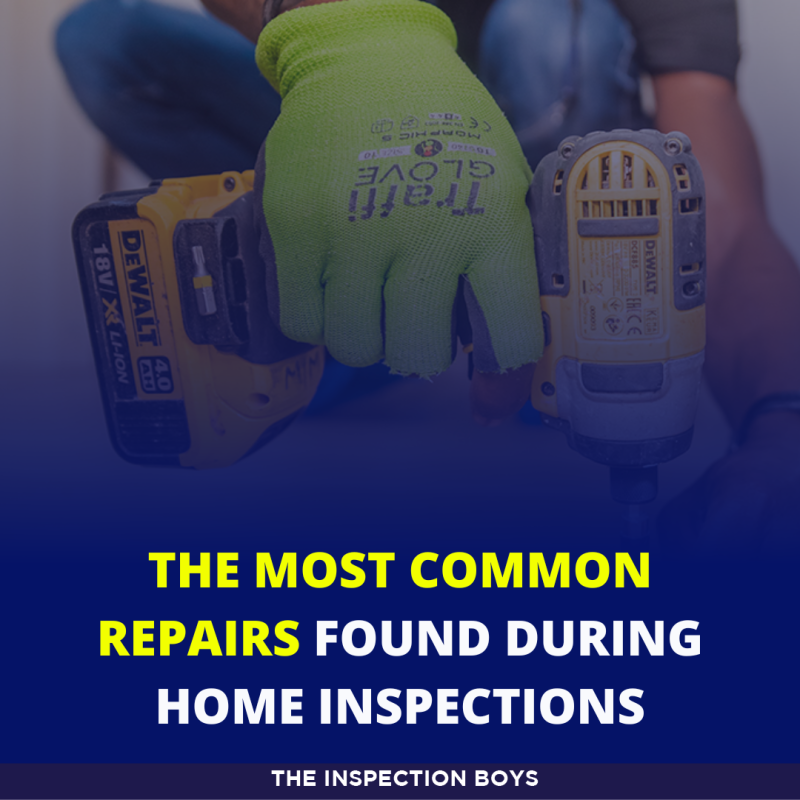A home inspection is one of the most crucial steps in the buying or selling process. It is the checkpoint that often reveals what a glossy listing photo does not: the real condition of the home. For both buyers and sellers, understanding what repairs commonly show up in inspection reports can save time, money, and a lot of last-minute stress.
Across thousands of inspections, certain problems show up again and again. These are not necessarily deal breakers, but they do matter. Here is a closer look at some of the most frequently flagged issues and why they matter.
Roof Issues
The roof is one of the most common areas where inspectors find problems. This can range from a few missing shingles to more serious signs of age, like granule loss, sagging, or active leaks.
Many homes, especially older ones, may have roofing near the end of its serviceable life. While sellers may not always realize it, buyers often view a worn roof as a major red flag. Repairs can include patching, sealing flashing, or full replacement in more severe cases.
Why it matters: A failing roof can lead to water damage inside the home, mold growth, and costly repairs that far exceed the price of preventative maintenance.
Electrical Deficiencies
It is not uncommon for inspectors to find outdated or unsafe electrical setups. This includes double tapped breakers, open junction boxes, outdated panels (like the infamous Federal Pacific Electric ones), or missing GFCI outlets in kitchens and bathrooms.
Older homes, in particular, may have knob and tube wiring or ungrounded outlets, both of which are flagged as safety concerns.
Why it matters: Electrical problems are more than inconvenient—they are dangerous. Faulty wiring is one of the leading causes of house fires.
Plumbing Problems
Leaky faucets, slow drains, or low water pressure often make the list. But more serious concerns like corroded pipes, improperly sloped drains, or signs of water damage also crop up.
Sometimes these issues are hidden behind walls or under sinks where homeowners do not regularly look. Inspectors use moisture meters and visual signs to spot trouble areas.
Why it matters: Left unaddressed, plumbing issues can lead to structural damage and mold. Fixing them early can prevent large scale repairs later.
HVAC System Concerns
Heating and cooling systems are another area where inspectors frequently find issues. These range from clogged filters and dirty ducts to systems that are well past their prime.
Inspectors often check whether the system is functioning properly, if it has been maintained, and whether there are signs of carbon monoxide leaks or poor ventilation.
Why it matters: An inefficient or failing HVAC system affects comfort, energy bills, and in some cases, health. Replacement costs are also substantial, making this a key concern for buyers.
Grading and Drainage Issues
Water pooling near the foundation or improper grading around the home is a common problem, especially on Long Island, where heavy rains and snowmelt are routine.
Inspectors may note signs of past water intrusion, mildew in the basement, or foundation cracks linked to poor drainage.
Why it matters: Water is one of a home’s biggest enemies. Poor drainage can undermine the foundation, lead to basement flooding, and create long term structural problems.
Foundation Cracks and Structural Shifts
Not all cracks are cause for alarm, but inspectors are trained to distinguish between cosmetic surface cracking and structural movement that could compromise the integrity of the home.
Hairline cracks in drywall or concrete are often benign. But wide, stair step cracks, sticking doors or windows, and sloping floors can point to foundation issues.
Why it matters: Structural repairs are among the most expensive and disruptive fixes a home may need. Early detection can inform decisions about negotiations and future maintenance.
Attic and Insulation Issues
Attics often go ignored by homeowners, but inspectors do not skip them. Common problems include poor insulation, signs of past or current rodent infestations, mold growth, or improper venting.
Lack of ventilation is especially problematic. It can cause heat buildup, moisture retention, and mold. Insulation that is poorly installed or degraded over time also reduces energy efficiency.
Why it matters: The attic plays a big role in regulating a home’s climate. Problems here can quietly increase utility bills and shorten the lifespan of roofing materials.
Windows and Doors
Sticky windows, deteriorated seals, or visible drafts are often noted. Rot around window frames and broken locks are also frequent finds.
While these may seem like minor annoyances, they can point to deeper issues like water intrusion or poor installation.
Why it matters: Functional windows and doors are key for security, energy efficiency, and overall home comfort. Small issues can add up to big costs if neglected.
Pest-Related Damage
Insect and rodent activity often gets uncovered during inspections, especially in crawlspaces and attics. Termites, carpenter ants, or mice can all leave behind clues: damaged wood, droppings, or entry points.
Even if pests are not currently active, signs of past infestations often require treatment or repair.
Why it matters: Pest damage compromises structural components and creates potential health risks. It is usually something buyers want addressed before moving in.
The Bottom Line
A home inspection is not about passing or failing. It is about understanding what you are buying or selling. Many of the most common repairs are not dramatic, but they matter. For buyers, these findings offer negotiating power and the chance to budget for repairs. For sellers, knowing what is likely to be flagged ahead of time can lead to a smoother transaction.
Either way, the key takeaway is this: homes age, and systems wear down. A home inspection helps bring those realities to the surface so nobody is caught off guard when the papers are signed.

